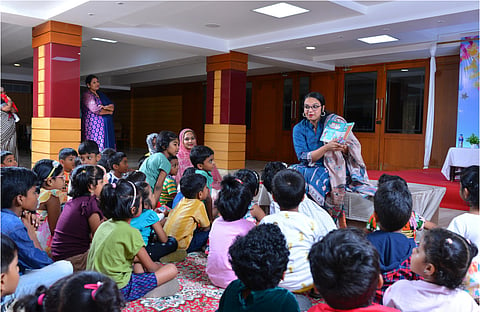

What if Kannagi and Madhavi were not rivals bound by the tragedy of a man, but friends — women who shared laughter over filter kaapi, reflecting on how love once led them astray? This reimagining forms the core of educator Vaishali BK’s mini-series, Favourite Feminists from Tamizh Literature, where she retells epics through a feminist lens on her Instagram page @ammatoday.tamizh.
Stories — historical or fictional — have often pitted women against one another, defined them through their relationships with men. Take Silapathikaram, for instance. Kannagi and Kovalan are married, but Kovalan falls for Madhavi, the daughter of a dancer, and leaves his wife. A year later, he returns, regretful, only to be wrongly executed for theft. Kannagi proves his innocence and curses the city, which then burns. Vaishali asks — what if, instead of being adversaries, Kannagi and Madhavi had supported one another? “I noticed a clear gap in Indian literature. Unfortunately, not many of us know about tales or characters, and I have wanted to do my bit to take these characters to more people,” she says.
Beyond sacred texts
According to Vaishali, Indian literature contains richly layered female characters who go far beyond roles of sacrifice or duty. These women experience and express jealousy, desire, lust, fury — emotions often scrubbed away in retellings. Understanding feminism in ancient Tamil classics, she says, requires acknowledging the era in which these works were created. “The time period of these stories was oppressive. But if you acknowledge the patriarchy that was prevalent and strip away these constructs, we find some women who are not subservient,” she notes. “These are the women who ask fundamental questions that make us think, make bold choices, and who fully embrace their identities.”
Through extensive research and personal insight, the TEDx speaker came to define a feminist character as someone who, despite societal limitations, asserted agency, created space for herself, and made choices that challenged norms or widened possibilities for others.
“These figures may not have used the language of feminism as we know it today, but through their actions, intellect, and moral strength, they carved paths that hinted at autonomy and empowerment,” she adds. “These may not necessarily be women who rejected traditional roles, but even within those roles, chose to question oppressive thoughts and live according to what felt right.” She cites Madhavi as an example — often miscast as a home-wrecker or victim, she was in fact self-made, principled, and loyal.
Challenging norms
Vaishali’s interpretations emerge from a close reading of texts and deep character analysis — understanding motivations, choices, and their relevance today. “The most surprising discovery for me is the gap between the actual work and the retold versions,” she notes. “In some cases, retellings add cultural value and perspective. In some cases, retellings are telling of a society’s priority at that time.” For example, the Lakshmana rekha doesn’t appear in Valmiki’s Ramayana, but features in later versions like Kamba Ramayanam.
These insights have pushed Vaishali to question her understanding of feminism itself. “How many of the choices some characters made were essentially feminist, and how many were personally driven by circumstance? I had to understand the waves of feminism and check my privilege as well. Would the choice of feminism apply here, or wouldn’t it be considering women were still an ‘oppressed’ gender?” Her reflections have turned her reading into a deeper dialogue with the past — not just as a scholar, but as a woman seeking connection across centuries.
Rebirthing characters
The series, which was launched on Instagram on March 7, features characters such as Nalayini, Karaikkal Ammaiyar, Kundalakesi, Manimegalai, Kannagi, Madhavi, and Devi Kanya Kumari. Vaishali hopes children will develop a curiosity about literature — not to accept versions handed down unquestioningly, but to examine them critically, consider themes like gender fluidity and social roles, and imagine change. “Most importantly, the viewers should develop a tolerance to consider different perspectives,” she says.
Not everyone has welcomed this reinterpretation. “(They) find it difficult to even view some characters without judgement,” Vaishali says. The series has sparked resistance in some quarters, but also found resonance among Tamil diaspora and expats longing to reconnect with their cultural roots. “This series has been a bridge between the traditional and modern for them,” she says.
Vaishali plans to explore both well-known and lesser-known characters — from Savitri to Neelakesi and Ratnavali, and even queer characters like Thaayumanaswami, who challenge gender norms.
The more stories she uncovers, the more she realises these narratives are not just about fidelity, but about strength. “Women who chose their husbands, stood by them, fought for them, women who demanded, women who rejected, women who ruled, showed resilience and encouraged or inspired the men,” she says. “It is about women who shine even in a patriarchal world, and I cannot help but feel awestruck and inspired.”